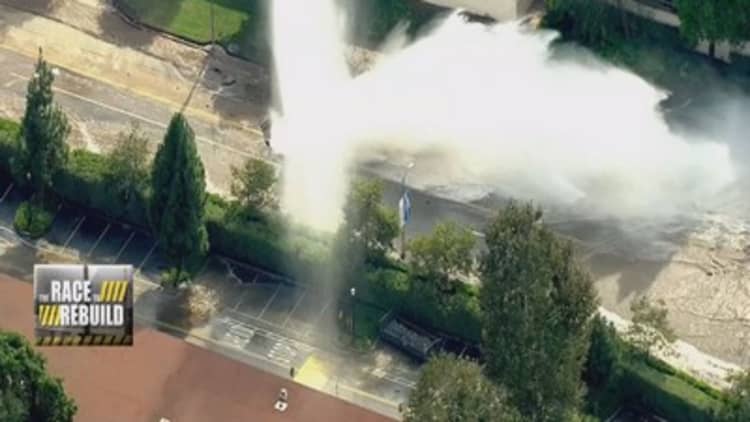
One-third of the country is in a drought, according to the federal government, affecting 95 million people. Despite the urgency, America is still losing a lot of water it still has.
For example: There are nearly a quarter-million water main breaks a year, according to the American Water Works Association. Two trillion gallons of drinkable water are lost annually due to a variety of reasons, including leaks, though that number is an educated guess. Nobody really knows for sure.
The underground infrastructure is getting old and needs to be replaced, but no one wants to pay for it. "It's hard to own something you don't see," said Madelyn Glickfeld of the UCLA Institute of the Environment and Sustainability.
Nowhere is the job of laying new pipe more daunting than in Los Angeles, where there are 7,000 miles of freshwater pipes under the city. "That's enough pipe to go from here all the way to New York and back," said Marty Adams, assistant general manager at the Los Angeles Department of Water and Power. Many of the pipes are almost a century old, including one that burst in spectacular fashion last year, flooding Sunset Boulevard and much of UCLA. Just this week in Newport Beach, a million gallons of water flooded a neighborhood because of a ruptured main.
The problem in many cities is that the infrastructure was built in with construction. "The original investments that are embedded in everyone's house price and every building cost, those have all now worn out, and so now we need new rate money to go in and replace all that," said Adams.
The DWP is trying to persuade ratepayers to pay 18 percent more on average to fund a speed-up in pipe replacement. What kind of speed-up? The department claims it can replace about 100 to 200 feet of pipe a day, and to replace the whole system would take nearly 300 years—three centuries—a number that seems incomprehensible. A rate hike would provide the funds to cut that time in half, adding $2.7 billion in the next five years alone. Adams said faster pipe replacement has a proven record, cutting the number of water main breaks by 40 percent.
But even as pipe bursts have become a common occurrence, the DWP faces a tough sell. It also deals with negative stories about mismanagement of funds, and in a city that uses half a billion gallons of drinkable water a day, Adams recognizes the challenge in persuading customers to pay more to maintain something they don't even think about. "It's underground, it's not very fancy, it doesn't get you anything new," he said.
Another issue facing the country is the lack of knowledge about how much water is lost. While the DWP claims it only loses about 3 percent of water a year to leaks or fire hydrants (which are unmetered), Glickfeld believes the real number has to be higher. "If you look to places like Israel and Australia, who've gone through a longer drought than ours, they say you can't get down below 10 percent (water loss). If you do, you're doing miracles."
She's supporting a bill in the state legislature to force water agencies to do annual audits determining how much water is lost so the state can determine how much leakage is "acceptable." The bill is an expensive proposition that the agencies are fighting.
"People are being asked to cut back by 10 percent, 20 percent, 36 percent their own use," Glickfeld said. "How will they feel if they know that there's 10 percent being lost, or 15 percent being lost, before it even gets to them, and they're paying already for that." Ratepayers are not paying directly for that lost water, as it never makes it to their meters. Instead, Glickfeld said everyone pays more when there's less total water available. "People don't really get it."
In the meantime, rate hike or no rate hike, the DWP's work continues replacing and improving the unseen guts under a city of 460 square miles. The only question is how quickly, and whether it's fast enough to stay in front of all the daily pipe failures. "We're living right now on the development that people put in when they built this city," said the DWP's Adams. "It's now our turn to come in there and replace that, upgrade it, and make it last for the next 100 years.




